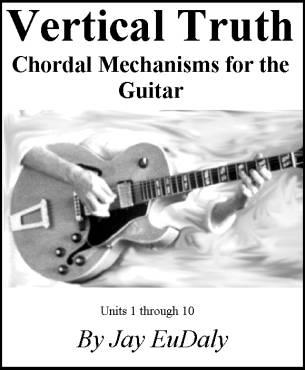This website is a first stab at a response to the demand from many students over the years to codify my approach to soloing and improvisation that derives from my harmonic knowledge as taught in my book, Vertical Truth – Chordal Mechanisms for the Guitar.
A fairly advanced understanding of harmony, that is, chord construction and voice leading, is presupposed. I have taken some students through these concepts only after they have completed at least nine out of ten units of the chordal material.
The material on this site is basically a teaser for my teaching business
(there is no substitute for one-on-one instruction), and will also form the basis for another book in the Vertical Truth series of method books for the guitar. The book will be much more exhaustive; it will have a greater variety of examples and cover stuff I've only hinted at on this site. I decided to build the site first - primarily as an exercise to begin the codification process - and also because building a website is more fun and immediately gratifying than writing a book.
In my formative years, the problem I was having was that when I listened to the players I was trying to emulate (George Benson, Pat Martino, Jim Hall, etc), I could hear the chord changes in their single note soloing. I wasn't hearing that in my own soloing and wondered how they did that.
During the course of my years of studying with John Elliott I realized that coming up with a method for soloing that referenced the harmonic knowledge I was learning from John was the solution to my problem. The obvious method was to structure my lines from arpeggios rather than scales or modes. This would make it easier to reference chordal structures rather than playing through chord changes using scale patterns. It takes the vertical (i.e. chords) concepts he taught (he called it the Theory of Harmony) and applies them horizontally to create melodic lines.
That was how it began. I began to noodle around with lines, creating a vocabulary that was based on arpeggio patterns rather than scale or modal patterns.
Because of where I was in my studies with John at the time, I started out with 7th chord arpeggios rather than triad arpeggios. I backdoored into the triad material when John covered soloing over bitonals (this corresponds to Unit 10 of my book). By that time I had already solidified my approach and was using and expanding it on the gig. I was gratified and affirmed to learn that John was basically using the same approach to soloing over extended altered chords that I had devised for more basic structures and so had no major problems adapting the approach to upper extension triads.
So I will begin with where I began, 7th arpeggios. However, I will first give a general explanation of how I use the Key Circle to order and apply musical theory to the guitar neck, and general definitions of the different types of 7th chords.
By the way: In general, I don't think that "self teaching" is a good way to learn. A qualified instructor can help you optimize the time and effort it takes to really progress on an instrument. While I've tried to be as concise and clear as possible in my explanations and directions (I could easily write pages of text for every page here), there's no substitute for one-on-one demonstration, interaction and question-and-answer. So, in lieu of real interaction, I've included short video clips on most pages in order to demonstrate the concept of the page.
Also by the way: With the exception of some fret board diagrams here and there there is no tab. My opinion of tablature is negative - there will be no tab. For my position on tab go here.
It is entirely appropriate, even necessary, to spend weeks - if not months - on every page after the "7th Chords" page. Arpeggios are much more difficult than scales as far as technique is concerned. There are all kinds fingering issues, for instance. 10,000 correct repetitions is a good start at it. Everything should be done in every key in every position possible. One of my main jobs as a teacher is to make sure the drilling actually gets done, correctly and exhaustively. So...if you don't understand something, or how to practice every possibility, maybe you should consider some formal lessons. You'll progress much faster that way.
On the way this site is structured: At the bottom of every page is a link to the next page. So by following those links you can go through every page - in order. The navigation bar across the top is minimal. The site index link will take you to an index of every page on the site.
Next: Key Circle Applied









